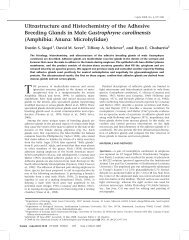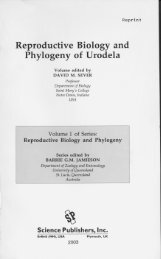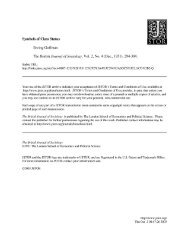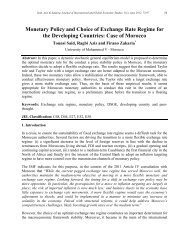Marvelous Facts and Miraculous Evidence in Early Modern Europe ...
Marvelous Facts and Miraculous Evidence in Early Modern Europe ...
Marvelous Facts and Miraculous Evidence in Early Modern Europe ...
Create successful ePaper yourself
Turn your PDF publications into a flip-book with our unique Google optimized e-Paper software.
114 Lorra<strong>in</strong>e Daston <strong>Facts</strong> <strong>and</strong> <strong>Evidence</strong><br />
tionally, private revelations, particularly sudden conversions, had counted<br />
as miracles, <strong>and</strong> many biblical miracles were directed at select persons or<br />
groups.60 However, many seventeenth-century theologians, particularly<br />
Protestant theologians <strong>in</strong>tent on discredit<strong>in</strong>g sacramental miracles,<br />
<strong>in</strong>sisted on "a public <strong>and</strong> visible demonstration."6' Second, experts (here<br />
the members of the House of Solomon) are needed to dist<strong>in</strong>guish the<br />
supernatural from the preternatural, natural, <strong>and</strong> artifical, <strong>and</strong> to guard<br />
aga<strong>in</strong>st fraud. S<strong>in</strong>ce the members of the House of Solomon actually experiment<br />
with "all manner of feats ofjuggl<strong>in</strong>g, false apparitions, impostures,<br />
<strong>and</strong> illusions" that might be disguised "to make them seem more miraculous,"62<br />
we may assume that Bacon himself was primarily concerned with<br />
human fraud. His contemporaries, however, also warned aga<strong>in</strong>st demonic<br />
fraud, though still achieved by manipulation of natural causes. Third,<br />
God ideally delivers the proper <strong>in</strong>terpretation of the miracle on the spot,<br />
<strong>in</strong> the form of revealed doctr<strong>in</strong>e (the Bensalemites receive a box conta<strong>in</strong><strong>in</strong>g<br />
the Old <strong>and</strong> New Testaments, plus an explanatory letter from St.<br />
Bartholomew), which forestalls conjecture <strong>and</strong> dispute. These three<br />
elements-publicity, <strong>in</strong>spection for fraud, <strong>and</strong> <strong>in</strong>terpretation <strong>in</strong> light of<br />
doctr<strong>in</strong>e-def<strong>in</strong>ed the seventeenth-century concept of the miracle as evidence.<br />
I shall discuss each <strong>in</strong> turn, show<strong>in</strong>g how all three tended to shift<br />
the focus of seventeenth-century debate from the evidence of miracles to<br />
the evidence for miracles.<br />
It is strik<strong>in</strong>g that those seventeenth-century writers most exercised by<br />
the topic of miracles were those who <strong>in</strong>sisted that miracles had long ago<br />
ceased. Protestants challenged by Catholics to produce miracles <strong>in</strong> attestation<br />
of their reformed faith retorted that there was no need for God to<br />
confirm the revelations of Christianity anew, for the Protestants meant to<br />
re<strong>in</strong>force, not break with the teach<strong>in</strong>gs of the Bible.63 Although there was<br />
some <strong>in</strong>ternec<strong>in</strong>e wrangl<strong>in</strong>g as to exactly when miracles had ceased,64 that<br />
they had done so many centuries ago was above dispute for Protestant<br />
authors. Edward Still<strong>in</strong>gfleet <strong>in</strong>quired rhetorically, "What imag<strong>in</strong>able<br />
necessity or pretext can there be contrived for a power of miracles, especially<br />
among such as already own the Div<strong>in</strong>e revelation of the Scriptures?" It<br />
would be otiose for God to heap miracle on miracle <strong>in</strong> order to re-prove<br />
60. See Romano Guard<strong>in</strong>i, "Das Wunder als Zeichen," <strong>in</strong> Studien und Berichte der<br />
Katholischen Akademie <strong>in</strong> Bayern, Heft 17, Wunder und Magie (Wiirzburg, 1962), pp. 75-93.<br />
61. See John Tillotson, "Jesus the Son of God Proved by His Resurrection," Tillotson's<br />
Sermons, ed. G. W. Weldon (London, 1886), p. 372.<br />
62. Bacon, New Atlantis, 2:375.<br />
63. Although this view had August<strong>in</strong>ian antecedents, it was vigorously revived by<br />
Calv<strong>in</strong> dur<strong>in</strong>g the reformation: see Jean Calv<strong>in</strong>, "Epistre," Institution de la religion<br />
chrestienne (n. p., 1541).<br />
64. See, for example, William Whiston, Account of the exact time when miraculous gifts<br />
ceas'd <strong>in</strong> the church (London, 1749).







